The Intel Xeon W Review: W-2195, W-2155, W-2123, W-2104 and W-2102 Tested
by Ian Cutress & Joe Shields on July 30, 2018 1:00 PM EST- Posted in
- CPUs
- Intel
- Xeon
- Workstation
- ECC
- Skylake-SP
- Skylake-X
- Xeon-W
- Xeon Scalable
Benchmarking Performance: CPU Legacy Tests
Our legacy tests represent benchmarks that were once at the height of their time. Some of these are industry standard synthetics, and we have data going back over 10 years. All of the data here has been rerun on Windows 10, and we plan to go back several generations of components to see how performance has evolved.
All of our benchmark results can also be found in our benchmark engine, Bench.
3D Particle Movement v1
3DPM is a self-penned benchmark, taking basic 3D movement algorithms used in Brownian Motion simulations and testing them for speed. High floating point performance, MHz and IPC wins in the single thread version, whereas the multithread version has to handle the threads and loves more cores. This is the original version, written in the style of a typical non-computer science student coding up an algorithm for their theoretical problem, and comes without any non-obvious optimizations not already performed by the compiler, such as false sharing.
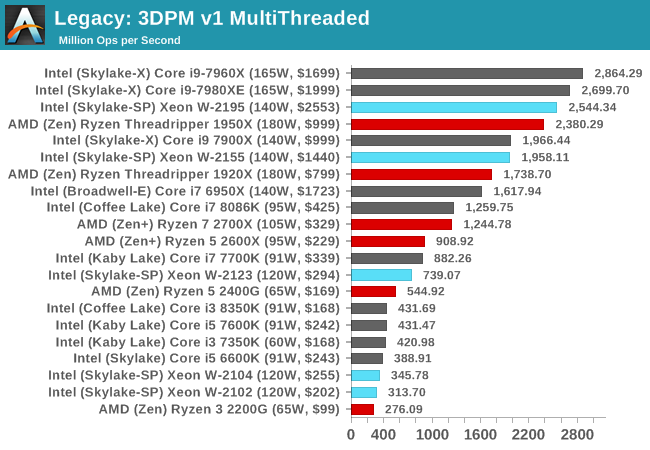
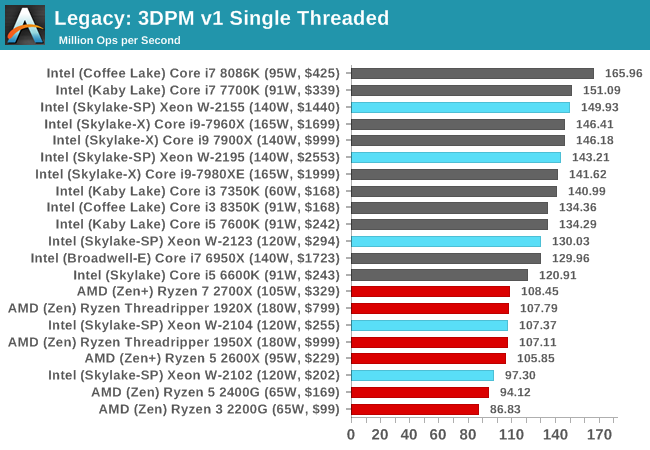
CineBench 11.5 and 10
Cinebench is a widely known benchmarking tool for measuring performance relative to MAXON's animation software Cinema 4D. Cinebench has been optimized over a decade and focuses on purely CPU horsepower, meaning if there is a discrepancy in pure throughput characteristics, Cinebench is likely to show that discrepancy. Arguably other software doesn't make use of all the tools available, so the real world relevance might purely be academic, but given our large database of data for Cinebench it seems difficult to ignore a small five minute test. We run the modern version 15 in this test, as well as the older 11.5 and 10 due to our back data.
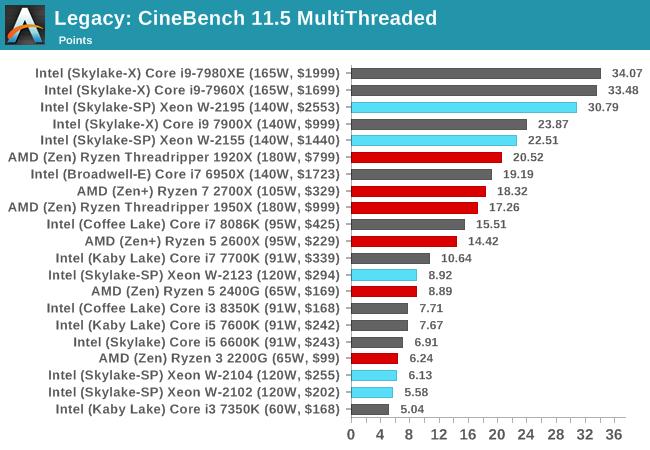
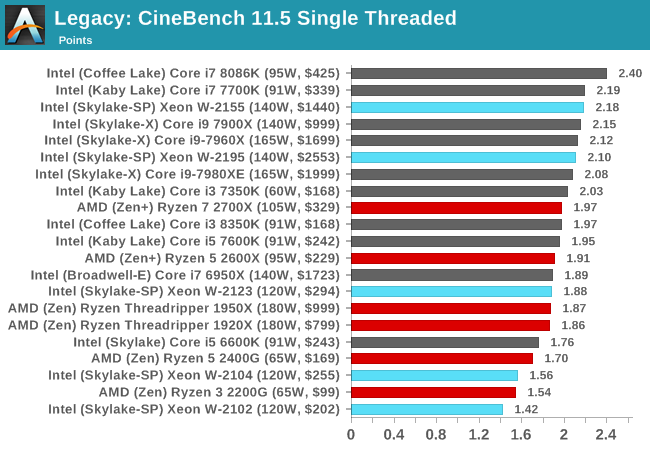
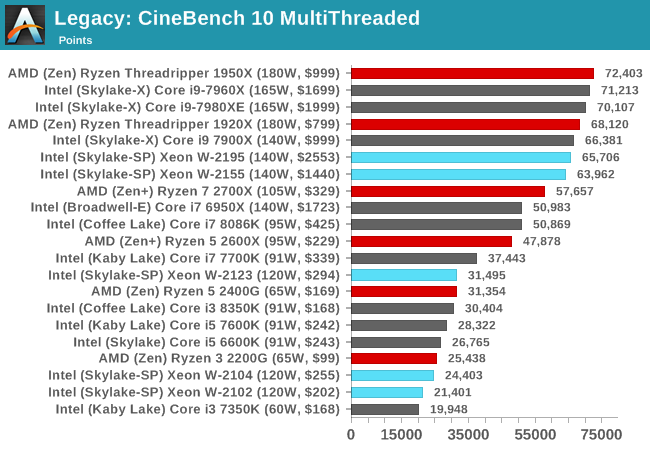
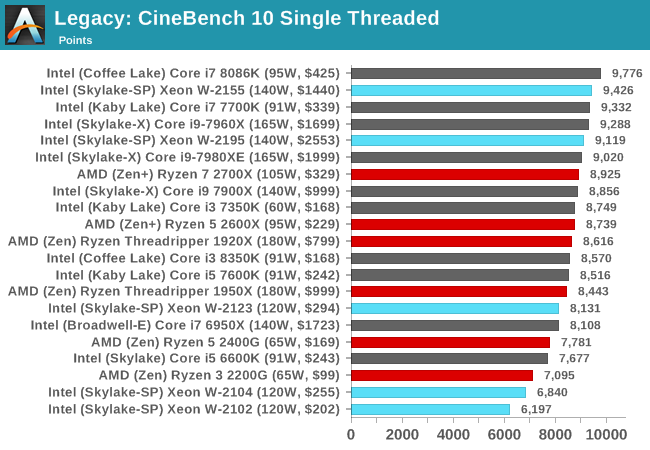
x264 HD 3.0
Similarly, the x264 HD 3.0 package we use here is also kept for historic regressional data. The latest version is 5.0.1, and encodes a 1080p video clip into a high quality x264 file. Version 3.0 only performs the same test on a 720p file, and in most circumstances the software performance hits its limit on high end processors, but still works well for mainstream and low-end. Also, this version only takes a few minutes, whereas the latest can take over 90 minutes to run.
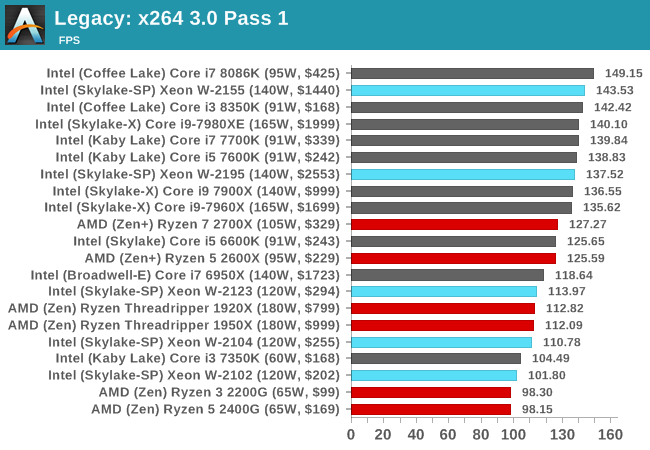
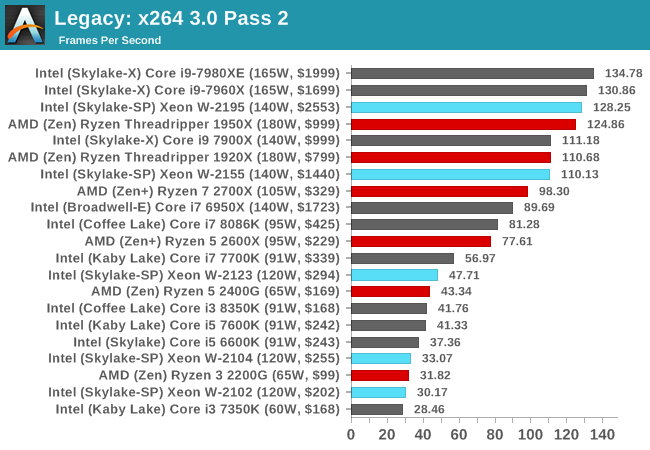










74 Comments
View All Comments
Ian Cutress - Monday, July 30, 2018 - link
If we ever get a Xeon Scalable system up and running for proper benchmarking, I'll run through some tests.JoJ - Saturday, August 4, 2018 - link
Hi Ian,I beg you to consider the futility of approaching HPE, to obtain a Z station and 56 Scalable cores, max RAM etc, may not may be wholly as anticipated.
I have a very high profile media production job coming, that could warrant a room of fully loaded such machines. Truly high profile. I have been always able to establish nearly immediate rapport with the marketing folk who are not apparently thought about by the UK online tech media, as warmly as I think it fair, but then I deal in printed worlds of very controlled readerships, and possibly by reflex alone I'm treated like I have more to say than I often do. But approaching the twenty five years mark, I probably ran out of lines some nineteen years ago anyway...
I care about hurling around heavily laden InDesign files, often without any media placeholders to include 409MB Hassleblad captures straight from the photographer. This project is going to be filled with custom adverts not run in any other media ever. (It took longer to agree copy for Rolls Royce than to sell the deal, in our first encounter with this project. VWAG owned both marques including Bentley, then.) Advertisers may visit, our job to produce for them their first display copy ever, because of interest from services who are in the word of mouth referral ecosystem this publication represents. We are effectively building a advertising studio, to accommodate the needs presented by, eg a long established security company, beyond public profile not by necessity or plan but rather not seeing the circle squared to deliver satisfactory result, without establishing unwanted capacity or staffing. So founder directors shall descend, for interview and portrait, the deal being approved by them signing a proof of the pages, in person, ideally we are able to complete 60% of the interview and layout remotely in advance.
I want to suggest to you that HPE could genuinely be intrigued by the client base of our project, and want to be exposed to them... mostly boutique banks and funds. A typical user is running a dozen Bloomberg Professional windows, Excel, with live updates and a lot of libraries for giving cell results, will have a terabyte or so of core textual references, between academic papers, email threads, online discussion (usually scraped) , and the job is to fill very specialist magazines with content and advertisers who don't play in the spray and pray brand game, but care everything about how they're found by a prospective new customer. So atop the trappings of a financial trader's desktop, will be layered Word, sure, but a TeX compositor, Visual studio, InDesign, PS...WHY? Because if we can get the message right, we can trade quickly to fill a matching campaign of the same redundancy as big ad buyers get, at even sharper prices. They come for creative, stay for flow execution.
It's realistic, even commonplace, for a Xeon Scalable workstation to find itself in front of board member powers, in this way.
Looking at the decisive commitment required to purchase current generation high end workstations, I assume that HPE, Dell et.al. just lean on their direct sales forces.
but strip away our Corporate veneer, and we're indistinguishable from any of your readers.
Individual buyers of workstation class computers, commonly inhabit the front line trenches of high end media production. London seethes with freelancer artists, driven by insufficient investment by employers, to fly solo simply to stay current with the tools and turnaround of their art. I can't win any argument about how far from the public imagination of the game, is the typical MB Pro user, sat elegantly in a WeWork chair, I thought my first sight of the Barbican WeWork office, was a film set... (whereas we're actually building a film set where to conduct our FOH business, because I can't vouch for the appearance of our actual digs. (Mr CIO left of his own accord, incapable of tolerating our disinterested views of fancy workspaces... the fact that our dev team is 80% founder level partner, actually never came into play, but the non attendance at his"corporate development" meetings, was protest against the idea of competing for hires with luxuries. Pity, in this one respect alone, the one character aspect we didn't believe necessary to investigate in interview, so patent is our third world architectural infrastructure, relations truly soured only because the guy was so good in every way otherwise. We just couldn't please with such capital commitments, not looking at the impending A grade glut just completing in the City. Such dangerous words; "absolutely, in the future, if you take us there, we will want a statement head office for sales etc". Just not on any immediate plans..
sorry, Ian, I am avoiding saying that I think I certainly could sell a HPE on the facts we know very well, where they'll be getting sales, in this sector at least, more from physical exposure to buyers and influencers, directly demonstrated the new generation capability by entirely non conveniently situated independent professionals and outside service companies, but absolutely nothing to look at in the kind of performance review I can't really understand is so homogeneous online, because this sort of evaluation hardly relates to the real use at all.
I am adamant that the entire presentation of high end desktop bixes is hostile and increasingly damaging to sales of performance workstations to corporate office buyers of all kinds.
Wall to wall gamer imagery has diluted the public perception of utilitarian power of computers beyond homeopathic insignificance.
Nothing, not a single word for twenty years- it seems to me - has conveyed any part of this crucial message: "With this new Intel computer, and the latest developments in the most advanced quantitative tools for generations, I WHOOP MY COMPETITIONS REAR!'
By all means, running a renderer matters in the industry that we inhabit. But the reason why we'll shell out for a 56 core beast, is so we can quickly previs a scene, while still working through the latest circulation data dump for the 200,000 or so publications we trade advertising on. Most days, we're rendering visuals of the data we don't want to take our concentration aeay from, again the reason why we're looking at the new HPE Z station Scalable workstations.
i have to be distracted but I'll conclude with guaranteed brevity upon my short return. There's plenty of angles here to get a vendor to cough up a couple of fully loaded machines for you, and I am entirely serious I'll invest the necessary time to get you a shot if you think I'm not batshii crazy. bfn
Elstar - Monday, July 30, 2018 - link
To be fair, the top end Core X and Xeon W have different TDP values.HStewart - Monday, July 30, 2018 - link
So does TDP values make bigger impact than actual Frequency - on same chip of course.BurntMyBacon - Tuesday, July 31, 2018 - link
It is more that TDP and frequency can no longer be separated. If you completely ignore TDP and fix the frequencies to their maximum, then TDP only matters in as much as you have the proper cooling solution to manage it. However, the actual running frequency of Intel's processors are tied into processor temperature, power, number of active cores, etc. On the same chip, a larger TDP means the processor can spend more time at higher frequencies or have more cores active at the same frequency.mode_13h - Monday, July 30, 2018 - link
The difference relative to X-series is probably due to thermal throttling due to dual AVX-512 and heat buildup under the non-soldered IHS.HStewart - Monday, July 30, 2018 - link
That would also be interesting test - I believe AVX-512 can be turned off in bios - not sure since I don't have one.JlHADJOE - Tuesday, July 31, 2018 - link
Lack of Turbo Boost 3.0 maybe?stanleyipkiss - Monday, July 30, 2018 - link
Besides the VM situation on Threadripper, why would anyone spend $2500+ for this?duploxxx - Monday, July 30, 2018 - link
what VM situation?